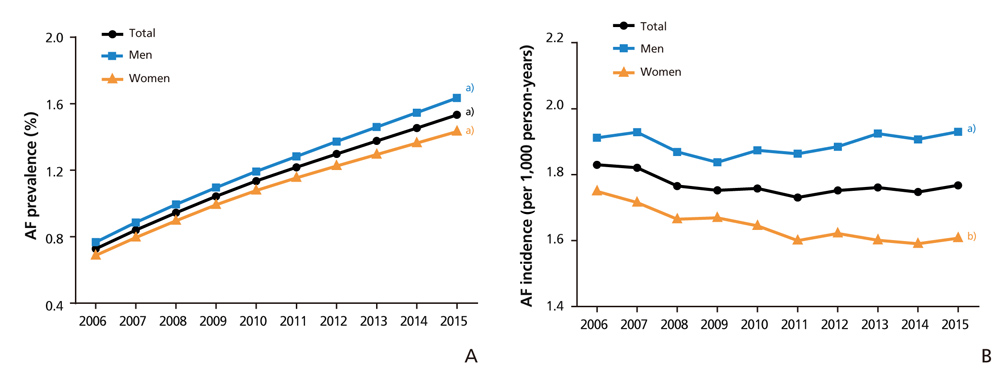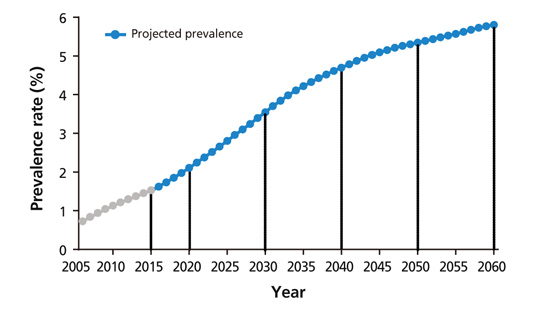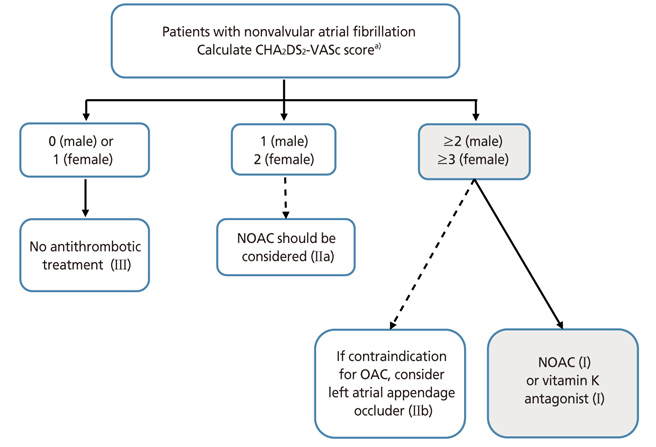J Korean Med Assoc.
2019 May;62(5):265-274. 10.5124/jkma.2019.62.5.265.
Guideline of atrial fibrillation management
- Affiliations
-
- 1Division of Cardiology, Department of Internal Medicine, Severance Hospital, Yonsei University College of Medicine, Seoul, Korea. cby6908@yuhs.ac
- KMID: 2445791
- DOI: http://doi.org/10.5124/jkma.2019.62.5.265
Abstract
- Atrial fibrillation (AF) is the most common sustained cardiac arrhythmia in the general population. The Korean Heart Rhythm Society organized a Korean Atrial Fibrillation Management Guideline Committee and analyzed all available studies regarding the management of AF, including studies on Korean patients. This guideline is based on recent data of the Korean population and the recent guidelines of the European Society of Cardiology, European Association for Cardio-Thoracic Surgery, American Heart Association, and Asia Pacific Heart Rhythm Society. Expert consensus or guidelines for the optimal management of Korean patients with AF were achieved after a systematic review with intensive discussion. This article provides general principles for appropriate risk stratification and selection of anticoagulation therapy in Korean patients with AF. This guideline deals with optimal stroke prevention, screening, rate and rhythm control, risk factor management, and integrated management of AF.
Keyword
MeSH Terms
Figure
Reference
-
1. Joung B, Lee JM, Lee KH, Kim TH, Choi EK, Lim WH, Kang KW, Shim J, Lim HE, Park J, Lee SR, Lee YS, Kim JB. KHRS Atrial Fibrillation Guideline Working Group. 2018 Korean guideline of atrial fibrillation management. Korean Circ J. 2018; 48:1033–1080.
Article2. Kim D, Yang PS, Jang E, Yu HT, Kim TH, Uhm JS, Kim JY, Pak HN, Lee MH, Joung B, Lip GY. 10-Year nationwide trends of the incidence, prevalence, and adverse outcomes of non-valvular atrial fibrillation nationwide health insurance data covering the entire Korean population. Am Heart J. 2018; 202:20–26.
Article3. Kim D, Yang PS, Jang E, Yu HT, Kim TH, Uhm JS, Kim JY, Pak HN, Lee MH, Joung B, Lip GYH. Increasing trends in hospital care burden of atrial fibrillation in Korea, 2006 through 2015. Heart. 2018; 104:2010–2017.
Article4. Yang PS, Ryu S, Kim D, Jang E, Yu HT, Kim TH, Hwang J, Joung B, Lip GY. Variations of prevalence and incidence of atrial fibrillation and oral anticoagulation rate according to different analysis approaches. Sci Rep. 2018; 8:6856.
Article5. Lee H, Kim TH, Baek YS, Uhm JS, Pak HN, Lee MH, Joung B. The trends of atrial fibrillation-related hospital visit and cost, treatment pattern and mortality in Korea: 10-year nationwide sample cohort data. Korean Circ J. 2017; 47:56–64.
Article6. Lee SR, Lee YS, Lim WH, Kim TH, Cha MJ, Lee JH, Baek YS, Lim HE, Joung B, Kim JS, Lee MY. 2018 Korean Heart Rhythm Society guidelines for detection and management of risk factors and concomitant cardiovascular diseases in Korean patients with atrial fibrillation. Korean J Med. 2018; 93:324–335.
Article7. Kim D, Yang PS, Kim TH, Jang E, Shin H, Kim HY, Yu HT, Uhm JS, Kim JY, Pak HN, Lee MH, Joung B, Lip GY. Ideal blood pressure in patients with atrial fibrillation. J Am Coll Cardiol. 2018; 72:1233–1245.
Article8. Kim TH, Yang PS, Yu HT, Jang E, Shin H, Kim HY, Uhm JS, Kim JY, Sung JH, Pak HN, Lee MH, Joung B, Lip GY. Effect of hypertension duration and blood pressure level on ischaemic stroke risk in atrial fibrillation: nationwide data covering the entire Korean population. Eur Heart J. 2019; 40:809–819.
Article9. Baek YS, Yang PS, Kim TH, Uhm JS, Park J, Pak HN, Lee MH, Joung B. Associations of abdominal obesity and new-onset atrial fibrillation in the general population. J Am Heart Assoc. 2017; 6:e004705.
Article10. Park J, Joung B, Kim J, Kim JB, Park HW, Park YM, Uhm JS, Ahn J, Lee DI, Kim JS, Lee MY. The 2018 Korean Heart Rhythm Society guidelines for integrated management of Korean patients with nonvalvular atrial fibrillation. Korean J Med. 2018; 93:336–343.
Article11. Kirchhof P, Benussi S, Kotecha D, Ahlsson A, Atar D, Casadei B, Castella M, Diener HC, Heidbuchel H, Hendriks J, Hindricks G, Manolis AS, Oldgren J, Popescu BA, Schotten U, Van Putte B, Vardas P. ESC Scientific Document Group. 2016 ESC guidelines for the management of atrial fibrillation developed in collaboration with EACTS. Eur Heart J. 2016; 37:2893–2962.
Article12. Lee JM, Joung B, Cha MJ, Lee JH, Lim WH, Kim TH, Shin SY, Uhm JS, Lim HE, Kim JB, Kim JS. 2018 KHRS guidelines for stroke prevention therapy in Korean patients with nonvalvular atrial fibrillation. Korean J Med. 2018; 93:87–109.
Article13. Steffel J, Verhamme P, Potpara TS, Albaladejo P, Antz M, Desteghe L, Haeusler KG, Oldgren J, Reinecke H, Roldan-Schilling V, Rowell N, Sinnaeve P, Collins R, Camm AJ, Heidbuchel H. ESC Scientific Document Group. The 2018 European Heart Rhythm Association Practical Guide on the use of non-vitamin K antagonist oral anticoagulants in patients with atrial fibrillation. Eur Heart J. 2018; 39:1330–1393.
Article14. Lee KH, Joung B, Lee SR, Hwang YM, Park J, Baek YS, Park YM, Park JK, Park HC, Park HW, Lee YS, Choi KJ. 2018 KHRS Expert Consensus recommendation for oral anticoagulants choice and appropriate doses: specific situation and high risk patients. Korean J Med. 2018; 93:110–132.
Article15. Lim WH, Choi EK, Joung B, Choi KJ. 2018 Korean Heart Rhythm Society guidelines for the rate control of atrial fibrillation. Korean J Med. 2018; 93:133–139.
Article16. Kang KW, Shim J, Ahn J, Lee DI, Kim J, Joung B, Choi KJ. 2018 Korean Heart Rhythm Society guidelines for antiarrhythmic drug therapy in non-valvular atrial fibrillation. Korean J Med. 2018; 93:140–152.
Article









